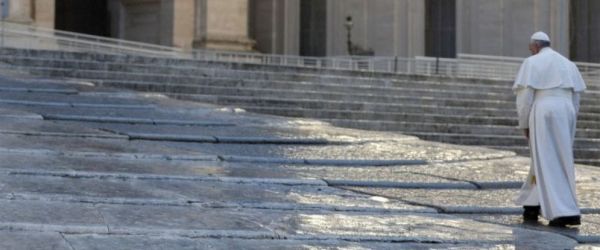On this Second Sunday of Lent, the liturgy leads us to contemplate the event of the Transfiguration in which Jesus allows the disciples Peter, James and John a foretaste of the glory of the Resurrection: a glimpse of heaven on earth. Luke the Evangelist (cf. 9:28-36) reveals to us Jesus transfigured on the mountain, which is the place of light, a fascinating symbol of the unique experience reserved to the three disciples. They go up the mountain with the Master, they see him immersed in prayer and, at a certain point, “the appearance of his countenance was altered” (v. 29). Accustomed to seeing him daily in the simple appearance of his humanity, they are astonished as they face that new splendour that also envelops his entire body. And Moses and Elijah appear beside Jesus and speak with Him about his forthcoming “exodus”, that is, of his Paschal death and Resurrection. It is a preview of Easter. Then Peter exclaims: “Master, it is well that we are here” (v. 33). He wished that that moment of grace would never end!
The Transfiguration occurs at a precise moment in Christ’s mission, that is, after he has confided to his disciples that he would have to “suffer many things, [...] be killed, and on the third day be raised” (v. 21). Jesus knows that they do not accept this reality — the reality of the Cross, the reality of Jesus’ death —, and so he wants to prepare them to withstand the scandal of the passion and death on the Cross, so that they may know that this is the way through which the heavenly Father will lead his Son to glory; by raising him from the dead. And this will also be the way for the disciples: no one can reach eternal life if not by following Jesus, carrying their own cross in their earthly life. Each of us has his or her own cross. The Lord reveals to us the end of this journey which is the Resurrection, beauty: by carrying one’s own cross.
Therefore, the Transfiguration of Christ shows us the Christian perspective of suffering. Suffering is not sadomasochism: it is a necessary but transitory passage. The point of arrival to which we are called is luminous like the face of Christ Transfigured: in him is salvation, beatitude, light and the boundless love of God. By revealing his glory in this way, Jesus ensures that the cross, the trials, the difficulties with which we struggle, are resolved and overcome in Easter. Thus this Lent, let us also go up the mountain with Jesus! But in what way? With prayer. Let us climb the mountain with prayer: silent prayer, heartfelt prayer, prayer that always seeks the Lord. Let us pause for some time in reflection, a little each day, let us fix our inner gaze on his countenance and let us allow his light to permeate us and shine in our life.
Indeed, Luke the Evangelist emphasizes the fact that Jesus was transfigured, “as he was praying” (v. 29). He was immersed in an intimate dialogue with the Father in which the Law and the Prophets — Moses and Elijah — also echoed; and as he adhered with his entire being to the Father’s will of salvation, including the Cross, the glory of God flooded him, even shining on the outside. This is how it is, brothers and sisters: prayer in Christ and in the Holy Spirit transforms the person from the inside and can illuminate others and the surrounding world. How often have we found people who illuminate, who exude light from their eyes, who have that luminous gaze! They pray, and prayer does this: it makes us luminous with the light of the Holy Spirit.
Let us joyfully continue our Lenten journey. Let us make room for prayer and for the Word of God which the liturgy abundantly offers us these days. May the Virgin Mary teach us to abide with Christ even when we do not understand or comprehend him because only by abiding with him will we see his glory.
[Pope Francis, Angelus 17 March 2019]












